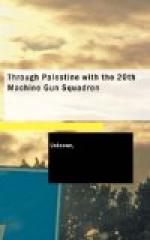The enemy’s position was on the mountains at the eastern side of the Jordan Valley, completely overlooking ours. Earlier in the year they had crossed the intervening ground, under cover of darkness, and attempted to send us to “Jericho”. They had found the posts too strong for them, however, and had retired to the positions now mentioned.
“C” Sub-section was on the left, on the banks of the Wadi Nimrin[19]—a broad wadi with a small stream running along its centre. This wadi ran right from the Turkish positions to the Jordan near the Squadron camp. “A” Sub-section was about half a mile away to the right in the centre of a cluster of small hills. “A’s” horses were between the two Sub-sections, and “C’s” were a few hundred yards behind its position under a cliff beside the Nimrin. If anything, it was probably more pleasant to be with the sections in the line than in the Squadron Camp.
Nothing of importance happened during our first week. Shells came over every day at unexpected moments in odd places, and Boche planes paid regular visits, dropping bombs, always, however, receiving a bombardment from our “Archies”. But on the morning of July 14th, after a night of more than the usual amount of artillery fire, shells began to fall all around, not to mention the shrapnel exploding overhead; this state of affairs continued throughout the whole morning. “No. 2” Section in camp was well protected by a high cliff, but “No. 3” was not so fortunate and had to be moved. All the horses had been taken to another spot, and Sergt. Lewis with some men were seeing that everything required had been removed, when a shell pitched right in the centre of the “lines” and wounded him and Ptes. H. Reed and L. Peach. All the day the shelling continued; the immediate neighbourhood of the bridges over the Jordan being the “warmest” spot. A field ambulance, close to the Squadron, behind the right reserve gun position, suffered badly. In the evening all shelling stopped—more suddenly even than it had started!
FOOTNOTES:
[18] The River Jordan is rich in historical associations, right from its source on Mt. Hermon to the Dead Sea, into which it flows. The Israelites crossed the Jordan on dry ground (Josh. iii, 14); our Lord was baptized there (St. John i, 28 and St. Matt. iii, 13). See also II Kings ii, 8, x, 14; Matt. iii, 5; St. John x, 40.
[19] See Isa. xv, 6.
A THWARTED TURKISH ATTACK.
Afterwards was learnt the cause of the excitement. The Turk, it was ascertained, had intended an attack all along the line. At one point, only, had the movement matured, and this was opposite the Australian Section, on our left. Here, German troops succeeded in getting right round some of the posts and endangering our bridgehead defences; they had moved guns up, which enabled them to reach places previously out of range of anything but their “heavies”. Although surrounded, the posts named still held out, and the Boches were finally driven back to their starting point, where, it is said, they were fired on by the Turks!




